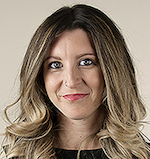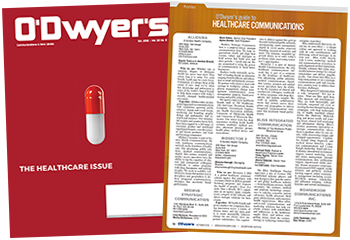 Maria English |
How would you describe your job as a PR professional to a friend, relative or neighbor? Would you talk about tactical communication? Would you say that you help healthcare organizations get their messages out to the market?
Those explanations would certainly be truthful. But the problem is that they’re only half-truths. And in many ways, they completely miss the point. A one-size-fits-all “get the message out” approach to today’s sophisticated healthcare consumer simply isn’t enough.
With the seemingly endless number of channels and tactics now available to reach your audiences, PR is no longer about pushing out broad, blanket messages to anyone who will listen. Rather, it’s about developing a strategic push/pull communication combination that reaches the right people and builds meaningful connections with them.
So, what does that mean, exactly?
It means understanding the distinction between talking at the market and engaging it in two-way dialogue. In other words, the job of today’s PR professional can best be summed up in a powerfully human way: we are relationship builders.
Use shared interests to build value
As our world changes, we must also change the way we think about PR and engage with that world. The task at hand is to build solid relationships by generating a sense of relevancy, trust and credibility among those in the market whom we want to reach.
This is no small feat in today’s climate, where distrust of media and other major institutions is at an all-time high. According to the 2017 Reuters Institute Digital News Report, for example, people across nine countries — including the U.S. — commonly perceive bias, spin and agendas within the news media.
Against this backdrop, successful healthcare PR requires a much deeper, more strategic evaluation of both the target audiences and the healthcare organizations themselves. Alignment is key. Effective PR is really about figuring out how to contribute significantly to the lives of others — i.e., your audience — in a distinct way that understands what they need.
This is done by acknowledging the two key components of every relationship: shared interests and value. As PR professionals, we must dance a continuous two-step: first step to discover the interests shared by our clients and their audiences; second step to enrich the conversation around those interests.
Let’s take a closer look at each step.
Step 1: uncover shared interests
This requires an honest look at who the client is from a business perspective, and what value they provide to target audiences.
The only way to do that effectively is to take a strategy seat at the table. That is to say, we as PR professionals must build strong relationships with the healthcare clients we represent. It’s essential to devote time to regular dialogue with multiple stakeholders across the business. Conversations should center around their business vision, their near- and long-term goals, and their expectations around how marketing and PR will help achieve their objectives.
Likewise, we need to thoughtfully scrutinize and understand who the target audience is at their core. We must look closely at their needs, motivators, behaviors, and preferences. When, where and how do they want to be reached?
Focus groups, social listening tools, ongoing analytics and other research can help reveal where a client’s interests intersect with those of its audience. Just as important, these tactics can point the way toward campaigns that encourage the kind of two-way conversations that start to nurture trust.
Socrates once said: “To know thyself is the beginning of wisdom.” We must help clients understand who they are, what they offer and the value they provide to the broader market, public and world. Too often, however, healthcare organizations fail to take a strategic look at the global value they provide and answer their audience’s #1 question: “Why should we care?”
Step 2: enrich the value conversation
A recent Gallup poll notes that 71 percent of Americans say the U.S. healthcare system is “in a state of crisis” or “has major problems,” a statistic that has remained relatively unchanged over the past decade. It doesn’t matter whether your client targets a B2B or a B2C healthcare audience; this is a significant public perception hurdle to overcome in the quest to strengthen relationships.
In fact, this perception makes it imperative for clients to communicate authentically about the value they deliver. They must demonstrate not only how their products and services improve healthcare tactically, but how they also benefit people more globally.
Consumers are savvy. They have high expectations of the organizations and brands they select, and it’s not just product features and services that win business. Very often, the reason a deal closes has as much — or more — to do with deep emotional connections created by a company’s passion, mission and vision. This can all be fostered through communication that is personal, meaningful and relevant.
At the end of the day, healthcare organizations must “keep it real” with a clear understanding of where their audiences are and the motivators that drive them. They must speak to why consumers should care about their offering more than anyone else’s offering. The challenge, of course, is that it takes time and effort to demonstrate value through authentic and genuine content.
Commitment: the key to lasting loyalty
There’s no way around it: professional relationships must be nurtured just as carefully as personal relationships. They require dedication and commitment. But the return on this “effort investment” is loyalty.
In a healthcare market crowded with content, real relationships built on shared interests and demonstrated value can cut through the clutter and build brand loyalty like nothing else can. For those PR specialists who are willing to act as matchmaker, the opportunity to build lasting relationships can go a long way toward both professional success and personal satisfaction.
***
Maria English is vice president, account management at MERGE Atlanta.



 Lo Isidro, senior director at Real Chemistry with more than a decade of strategic communications and PA experience, has joined Narrative Strategies.
Lo Isidro, senior director at Real Chemistry with more than a decade of strategic communications and PA experience, has joined Narrative Strategies. Nelson Fernandez, former North American chair of APCO Worldwide and managing director of Burson-Marsteller, has joined Volunteers in Medicine Berkshires as director of communications and PA.
Nelson Fernandez, former North American chair of APCO Worldwide and managing director of Burson-Marsteller, has joined Volunteers in Medicine Berkshires as director of communications and PA. Lilit Bargar, who was most recently an EVP in the healthcare practice at Weber Shandwick, comes on board at GCI Health as EVP, corporate practice lead.
Lilit Bargar, who was most recently an EVP in the healthcare practice at Weber Shandwick, comes on board at GCI Health as EVP, corporate practice lead.
 Five ways that successful thought leaders are made.
Five ways that successful thought leaders are made.


 Have a comment? Send it to
Have a comment? Send it to 
No comments have been submitted for this story yet.